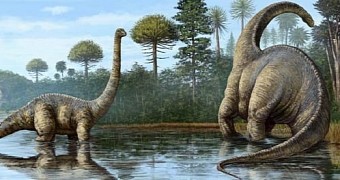A new paper in the Journal of Vertebrate Paleontology announces the discovery of several dinosaur tracks deep inside a diamond mine in Africa. Paleontologists say that, of these tracks, some still preserve skin impressions.
It is understood that, following the discovery of these tracks, workers were told to cease all mining activities in the area where they were found for a period of 8 months.
During this time, researchers took their time studying the dinosaurs footprints and did their best to come up with ways to preserve them while at the same time making it possible for mine employees to carry on with their work.
A rather unique find
As detailed in the Journal of Vertebrate Paleontology, the 18 dinosaur tracks were found in the Catoca mine in Angola. Paleontologists say that they are roughly 118 million years old and that they were created by sauropods.
This group of dinosaurs emerged in the late Triassic Period and soon enough spread to nearly all corners of the world. Thus, fossilized sauropods remains have been found on every continent, Antarctica included.
As shown in the image accompanying this article, sauropods had freakishly long necks, equally impressive Tails, and legs that looked very much like seriously oversized pillars. When compared to their rest of this body, their head was oddly small.
Interestingly enough, paleontologists explain that the tracks discovered in the Catoca mine are the first dinosaur footprints to have until now been found anywhere in Angola. They were first spotted by paleontologist Octávio Mateus back in July 2011.
Other tracks found in the same area
Paleontologists add that, apart from these sauropod footprints, Angola's Catoca mine also serves as a home to several tracks left behind by an ancient crocodile-like animal and a long-lost mammal.
Like the dinosaur footprints, these other tracks date back to 118 million years ago and were found in a small sedimentary basin. The thing is that, for the time being at least, researchers cannot say for sure exactly which animals created these other footprints.
Judging by their size, the mammal tracks are argued to have been left behind by an animal about the size of a raccoon, EurekAlert informs. However, paleontologists are yet to find any fossilized remains that might help them put together a portrait of this creature.
What's interesting is that, at the time this ancient mammal left its footprints in the sedimentary basin in the Catoca mine, present-day Angola was mostly populated by mammals no bigger than a rat. Hence, the footprints created by the raccoon-sized animal have researchers scratching their heads.

 14 DAY TRIAL //
14 DAY TRIAL //